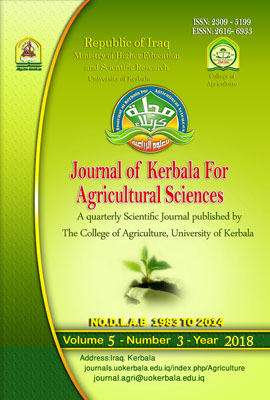Effect of Organic and Bio-fertilizer on some yield and quantity parameters for two strawberry varieties Fragaria× ananassa Duch
DOI:
https://doi.org/10.59658/jkas.v5i3.515Keywords:
Strawberry, Fragaria x ananassa Duch, Organic fertilizer, Bio- fertilizer, Quality parameters.Abstract
The study was conducted in Horticulture and Forest Unit at Al-Najaf Agriculture directorate during 2016-2017 growing season, to study the effect of adding some Bio and Organic fertilizer on yield and some quality parameters of strawberry (Fragaria x ananassa Duch) cultivated in plastic house.
The first factor included two varieties of strawberry: Albion and Burtela while the second factor was adding seven treatments of organic and bio-fertilizer including: without adding fertilizer (control), adding Azotobecter chroococcum (10g.plant-1), adding of Bacillus subitls (10 ml. plant-1), spraying of organic fertilizer Appetizer (1 ml. plant -1), adding of A.chroococcum + B. subitls, adding A.chroococcum + spraying of Appetizer, adding B. subitls + spraying of Appetizer and adding of A.chroococcum + B. subitls with spraying of Appetizer. Factorial experiment using Randomized Complete Block Design ( R. C. B. D) with three replicates were used.The Duncans multiples range test at 0.05 probabilities was adopted to compare the treatments means.
The Bortila variety was significantly increased the fruits number to 27.08 fruit. Plant -1, weight fruit rated to 25.05gm.fruit-1 and yield to 675.50 gm. Plant-1.The type of fertilizer showed a significant increase with adding A.chroococcum + B. subitls + Appetizer sprayed fruit number to 30.00 fruit.plant-1, and fruit weight rated 27.97gm.fruit-1 The Albion variety markedly increased total sugar to 10.54 mg.100gm fresh weight-1, while the Burtela variety showed significantly increase total acidity to 4.29mg.100g fresh weight-1and ascorbic acid to 33.73 mg.100gm fresh weight-1.
The fertilizer of A.chroococcum + B. subitls + Appetizer sprayed significantly increased total sugar to 12.11 mg.100gm fresh weight-1, while nitrate content reduces to 14.13mg.100gm dry weight-1. The treatment of A.chroococcum + Appetizer sprayed significantly increased Ascorbic acid to 55.47 mg.100gm fresh weight-1. The control treatment showed significant increase in total acidity 5.35 gm.100gm fresh weight-1 and nitrate content to 19.45 mg.100gm dry weights-1.
Downloads
Published
How to Cite
Issue
Section
License
Copyright (c) 2018 Copyright (c) 2024 is the Author's article. Published by the Journal of Kerbala for Agricultural Sciences under a CC BY 4.0 license

This work is licensed under a Creative Commons Attribution 4.0 International License.
Licensing Terms
All articles are published under a Creative Commons License and will be directed to the Creative Commons Attribution 4.0 International License (CC BY 4.0) That permits use, distribution, and reproduction in any medium, provided the original work is properly cited. This license also allows the work to be used for commercial purposes.
Use by both non-commercial and commercial users
This content is licensed under a Creative Commons Attribution 4.0 International (CC BY 4.0) license, permitting use by both non-commercial and commercial users. Individual users may access, download, copy, display, and redistribute the articles to colleagues, as well as adapt, translate, and text- and data-mine the content, subject to the following conditions:
- The author's moral rights, including the right of attribution and the right to protect their work from derogatory treatment, are respected.
- Where content in the article is identified as belonging to a third party, users must ensure that any reuse complies with the copyright policies of the owner of that content.
- If the article content is reused for research or educational purposes, users should maintain a link to the appropriate bibliographic citation, including the DOI and a link to the published version on the journal's website.






